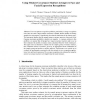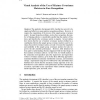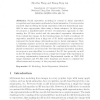45 search results - page 1 / 9 » Using Mixture Covariance Matrices to Improve Face and Facial... |
AVBPA
2001
Springer
13 years 9 months ago
2001
Springer
In several pattern recognition problems, particularly in image recognition ones, there are often a large number of features available, but the number of training samples for each p...
AVBPA
2003
Springer
13 years 10 months ago
2003
Springer
The quadratic discriminant (QD) classifier has proved to be simple and effective in many pattern recognition problems. However, it requires the computation of the inverse of the sa...
CVPR
2004
IEEE
14 years 6 months ago
2004
IEEE
Recognition difficulty is statistically linked to ??? subject covariate factors such as age and gender for three face recognition algorithms: principle components analysis, an int...
ECCV
2008
Springer
14 years 6 months ago
2008
Springer
Facial expression modeling is central to facial expression recognition and expression synthesis for facial animation. Previous works reported that modeling the facial expression wi...
DAGM
2003
Springer
13 years 10 months ago
2003
Springer
A new direction in improving modern dialogue systems is to make a human-machine dialogue more similar to a human-human dialogue. This can be done by adding more input modalities, e...



